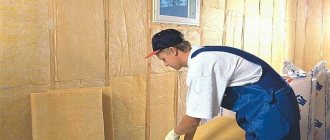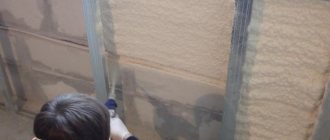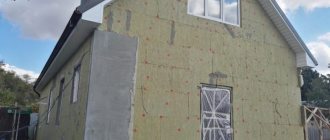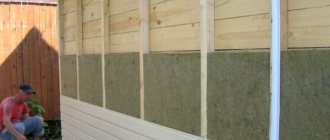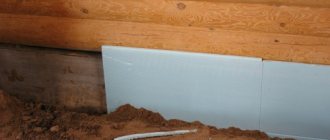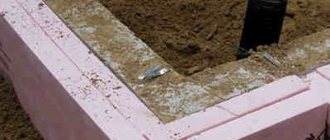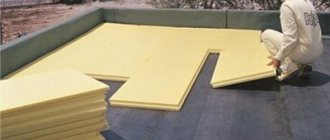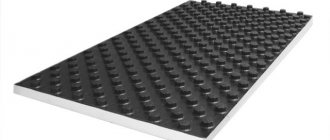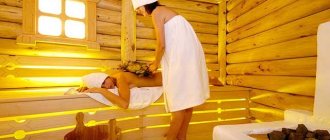The most effective method of insulating walls is external insulation.
Thanks to it, you can retain heat without reducing the area of the room.
An extremely important advantage of this thermal insulation method is that the external walls will retain heat .
Insulation of the external walls of a brick house is the optimal method of thermal insulation of a building.
The following materials are suitable for insulation:
- mineral wool;
- Styrofoam;
- extruded polystyrene foam;
- penoplex;
- penofol;
- penoizol;
- polyurethane foam.
We will look at some of them in this article.
Internal and external insulation - features and nuances
A wall that is insulated from the outside will cool several times slower. The undoubted advantages are:
- Heat losses are minimal;
- The dew point is located either in the insulation itself, or at the edge of the outer wall (it all depends on the parameters);
- Condensation will never form on the wall;
- The wall warms up completely, there are no significant temperature jumps .
Differences in insulation
Internal wall insulation is not considered so popular, all due to a number of significant disadvantages:
- Heat is lost by 10%.
- Dew point location . It is located in the space between the inside of the wall and the insulation or in the insulation itself. This causes condensation to accumulate, and after a while dampness appears in the room.
- The wall does not retain or accumulate heat.
Despite a number of disadvantages, internal insulation is also characterized by positive qualities:
- Work can be carried out at any time of the year, regardless of weather conditions.
- It is easy to carry out insulation yourself; for this you only need basic knowledge and the necessary materials.
Main types of insulation and their brief description
Organic heat insulators on the market are represented by a wide range of products.
They are based on materials of natural origin:
- Arbolite insulation is considered the newest material, which is based on sawdust, shavings, uncut straw and reeds. Also, the insulation is made of cement and organic additives. These are CaCl2, H2SO4, as well as the product obtained after processing ordinary clay, kaolin or nepheline, and Na2O.
- Foam-polyvinyl chloride insulation . It consists of polyvinyl chloride resin, which, after exposure to light or electromagnetic vibrations, acquires a characteristic foam structure. At the same time, it is considered a universal heat insulator.
- Chipboard insulation . Components - shavings, resin obtained as a result of controlled chemical processes, antiseptics, fire retardant.
- Insulation with a fiberboard base . It resembles chipboard in its own way. The base is wood waste, or trimmed corn and straw stalks. The material may well also consist of compressed old paper.
- Polyurethane foam is based on polyester , it includes H2O, an emulsifier and isocyanates. When catalysts begin to act, all elements interact as a result of a chemical reaction, in which a new type of insulation appears.
Inorganic heat insulators
Mineral wool comes in two types: slag and stone . To produce the first, companies use slag. Stone wool is distinguished by: CaCO3, rocks that are used for paving streets, minerals containing calcium and magnesia, volcanic rocks and others.
External insulation of brick walls - how to choose optimal thermal insulation?
Minvata
This concept includes the following varieties:
- glass wool, as well as stone wool;
- slag wool
All these materials are characterized by corresponding fibers, which are based on glass, rocks, and slag.
Averages:
- thermal conductivity – 0.041-0.044 W/(mK);
- impermeability – 20-200 kg/m3.
IMPORTANT!
Before deciding whether to insulate a brick facade with this material, it is necessary to take into account that it is prone to excessive absorption of moisture . Therefore, it is additionally treated with special chemical materials.
Mineral wool
Styrofoam
An oversized material, which, due to its characteristics and affordable price, has become the most popular material for thermal insulation . In the construction market you can always find a copy whose average indicators are:
- thermal conductivity – 0.033-0.037 W/(mK);
- impermeability – 11-35 kg/m3.
Foam plastic is practically free from moisture, plus it is vapor-proof. In addition, the material is quite fragile, easily flammable, and during smoldering it releases many dangerous chemical elements. This material has many disadvantages, but it is ideal as an economical option.
Styrofoam
Extruded polystyrene foam
In terms of its characteristics, the material resembles the foam plastic described above, only there is one difference - exclusively the latest developments are used in its production.
Averages:
- thermal conductivity – 0.028-0.032 W/(mK);
- impermeability – 25-38 kg/m3.
It is often used for external insulation; it is quite strong and retains heat well. Naturally, its cost is several times higher than that of the two options discussed above.
Warm plaster
It is distinguished by sound insulation and vapor permeability.
Characteristics:
- thermal conductivity – 0.065 W/(mK);
- impermeability – 200-340 kg/m3.
This is an ideal insulation material for cladding the external wall of a brick house, but requires special conditions due to its characteristics:
- layer of plaster no more than 50 mm;
- the foundation must be further strengthened.
Plaster
Useful video
How to insulate a brick wall with your own hands:
Brick is a classic material for building a house, designed to last for many decades of use. The thermal conductivity of brick walls depends on its thickness - the number of rows of masonry. If a wall in a brick house freezes in the first winter after construction, this means that the construction technology has been violated or the thickness of the enclosing structures is insufficient. In this case, it is necessary to resolve the issue of thermal insulation of the external walls of the building. Priority should be given to external insulation, but its installation is not always possible. Let's look at how to insulate a brick house from the inside, what materials are preferable to use and how to properly carry out the installation of thermal insulation.
Human activity is associated with a large release of heat and moisture. Heat is emitted by bodies and household appliances. Moisture is released during breathing, during cooking, using water for hygiene procedures, washing dishes, and watering flowers. And the warmer the air, the better it retains moisture.
If the walls are not insulated enough, condensation will form on them when the heated, humid air cools. It will provoke the development of fungus, and dark spots will appear on the surface of the walls and ceiling. Fungal spores are harmful to human health - they enter the respiratory system, causing asthma attacks or an allergic reaction. In addition, mold has a destructive effect on the materials from which the walls are built and irreparably damages the finish.
Before insulating the walls of a brick house from the inside, it is advisable to understand how this will affect the operating conditions of the external walls and the microclimate in the room.
Where to place the insulation?
It is correct to insulate buildings from the outside, otherwise condensation of moisture from steam cannot be avoided when warm air comes into contact with a cold front (dew point). Let's consider three types of brick walls:
There is no insulation. The dew point is located in the thickness of the wall, so it accumulates moisture during the winter months, becomes damp and deteriorates over time. The insulating layer is located on the side of the room. The wall freezes through, causing the dew point to shift toward the room, to the inner surface of the enclosing structure. Because of this, moisture condenses between the heat insulator and the wall. To avoid dampness of the wall, it is necessary to provide effective ventilation of the room. The insulating layer is laid on the street side. The wall does not freeze, so it remains dry and freely releases steam outside
It is important that there is a ventilation gap between the insulating layer and the brickwork to remove moisture coming from the room.
Internal instead of external
Obviously, insulating a brick house from the inside is not the best solution. However, you have to resort to it if:
- The building is an architectural monument, and it is prohibited to make changes to the appearance of the facade.
- The walls of an apartment in a multi-story building freeze. According to current standards, it is forbidden to install structures that change the appearance of the building without permission.
- The buildings are located close to each other, which makes it impossible to carry out work on external insulation of the walls.
- The external masonry of the house is made of expensive facing bricks and it is a pity to cover it with new finishing, and in order to lay a new external layer of decorative bricks after installing the thermal insulation, additional serious financial investments are required.
The disadvantages of insulating internal walls include reducing the space of the room due to the fastening of insulation and the base for finishing. The thickness of the thermal insulation “pie” is usually at least 10 cm.
When installing a heat insulator inside the house, it is important to take into account that insulating the internal surfaces of the walls threatens condensation, which should not be allowed
Vapor permeability
In order for the living space to breathe well and the air not to be overly humidified, high-quality ventilation is necessary. In buildings with brick walls it is easy to breathe, since the material is vapor permeable due to its porous structure
And so that excess moisture does not condense under the insulation layer on the wall, but freely leaves the room, an important rule must be observed - vapor permeability must increase towards the outside, i.e. to the street
This means that when insulating brick walls from the inside, you cannot use materials that allow steam to pass through better than the brick itself. Otherwise, this will lead to condensation settling on the structures. That is, covering a freezing wall with plasterboard will provoke constant dampening of the structures during the cold season.
Thermal panels
This material is distinguished by both thermal insulation and the ability to cover the surface of walls..
Characteristics:
- thermal conductivity – 0.025 W/(mK);
- impermeability – 45-55 kg/m3.
NOTE!
Today on the market you can find panels that are produced as imitation siding or lining. They are covered with a special quartz coating.
Thermal panels
Pie wall - what elements does a brick wall consist of?
- Plaster - from 10 to 35 mm depending on the chosen option for the brick wall;
- Hollow or solid brick;
- Foam plastic PSB 25 (from 70 to 120 mm);
- Steel lathing;
- Vapor barrier and wind barrier multifunctional membrane.
- Plaster or mortar known;
- External finishing - facing brick or decorative plaster.
wall pie
A few words about waterproofing and vapor barrier
At the stage of thermal insulation of the wall, it is necessary to pay special attention to the vapor barrier, otherwise the insulating material will become unusable after some time. The classic material for vapor barrier is polyethylene.
When installing, you must handle it extremely carefully and do not pull it too hard, otherwise the film may become deformed, especially during seasonal changes in climatic conditions.
Waterproofing
A frequently used vapor barrier material is considered to be mastics specially created for this purpose. If they are applied to the wall, they will allow air to pass through while retaining moisture. Waterproofing protects various building structures from moisture penetration. It is easy to apply, does not require special qualifications from workers, and does not form seams.
For brick walls, plaster is often used instead of vapor barrier, which is not very true in the case of mineral wool, because the insulation will begin to dampen.
Vapor barrier and waterproofing
How to insulate the outside of a house with your own hands using penoplex and polystyrene foam
Thermal insulation boards of polystyrene foam and penoplex are used mainly for insulating brick, block and concrete walls of houses. When the surface of the outer wall is prepared, they begin to insulate the house from the blocks from the outside
If foam plastic is used as an insulating material, it is very important to thoroughly dry the walls, otherwise the material may become saturated with moisture and lose its thermal insulating properties. This nuance especially needs to be taken into account before insulating a block house from the outside.
How to insulate a house made of foam blocks from the outside with foam plastic for subsequent finishing with decorative plaster? Sheets of foam plastic or penoplex are attached to the wall using a special adhesive. In order to glue the first row of slabs evenly, it is recommended to fasten the finishing strip along the bottom edge of the wall. After applying the glue, the sheets are pressed against the wall with little force. You can additionally fix the sheets using mushroom dowels in the center and corners of the sheet. Using a level and plumb lines, the plane of the applied foam layer is controlled.
Sealing cracks and preparing sheathing
It is better to replace damaged walls or carry out major repairs. Gaps in joints are sealed with natural materials or synthetic stone sealants .
Before insulating the wall, you need to take care of preparing the sheathing. The distance between its bars should be determined based on the width of the insulation slab . It is important to use a building level to check the vertical and horizontal surface for finishing. The sheathing bars should be directed perpendicular to the direction of the facing panel.
Brick wall sheathing
Do not forget about installing transverse sheathing to ensure high-quality ventilation.
For the convenience of installing intermediate elements of the sheathing, a rope is pulled from the corner beam from below and above the facade . Some people mark future elements with chalk.
Foam insulation based on the wet facade principle
Foam panels or panels made of extruded polystyrene foam should be attached to the walls using the simplest technology, which is called a wet facade. This technology received this name due to the presence of certain processes that require drying.
Algorithm of actions:
- Preparation of a brick wall, which consists of cleaning from dirt, eliminating defects, as well as priming. The seams between the brickwork should be thoroughly cleaned.
- At the level of the base, a metal profile should be attached, which will be the starting point when laying the first row of insulation, and will act as a drip line to collect moisture.
- Glue should be applied pointwise to the insulation boards and pressed against the wall.
- Next, additional fastening is performed using dowels, which should be done in the center and in the corners.
- All work must begin from below the corner, and the rows must be laid offset, which ensures stability of the entire structure.
- A plastic reinforcing mesh must be installed on top of the finished insulation layer. A thin base coat of plaster should also be applied.
- After the solution has dried, it is necessary to begin priming and final finishing using decorative plaster.
Insulation of a brick wall from the outside using mineral wool as an example
- On the outside, the brick base must be sheathed with OSB boards ; gaps must be maintained between them, the size of which is indicated by the manufacturer. After installation, the gaps are filled with foam.
- Then, on the outside, a membrane with waterproofing is stretched, which protects the mineral wool from moisture , on top of which all exterior finishing will be carried out. Many companies produce waterproofing materials with strips on which connecting elements are applied for a tighter joint. If such strips are missing, the joints should be glued with double-sided tape.
- Then sheets of mineral wool are tightly installed . Often a material is used whose density starts at 35-50 kg/m3. A material with a lower density will certainly settle or roll off, which will cause cold to pass through the formed voids.
- Mineral wool slabs are installed so that the previous mine connections are covered. by 150-200 mm. The overall insulation thickness is based on climate and temperature indicators, but the average is 150 mm.
- After laying the sealant into the walls, all voids that appear are filled with film for installation.
Insulation with mineral wool
Insulation under siding
Performing thermal insulation work
Technologies for carrying out installation work are selected based on the selected type of insulation and method of decorative finishing. In particular, with mortars or lathing. Let's look at the methods using examples of three groups of materials.
Using mineral wool
Fiber insulation is characterized by softness, so lathing is required here. The material is immersed in the cells and further strengthened by “fungi”. To protect the insulator, a water barrier is formed or a vapor-permeable membrane is laid. After filling the counter-lattice, decorative finishing is carried out using modern cladding materials.
Insulation of external walls with mineral wool
Foam insulation
If you plan to sheathe the walls, then the insulation technique is similar to when working with mineral wool. The only difference is the additional foaming of the installation gaps between the slabs and the sheathing. They are needed to compensate for the thermal expansion of dissimilar materials.
The second method is gluing the slabs with glue. Before this, the walls are leveled and primed with an adhesive compound. The solution is applied to the insulation or base in an even layer. The canvases are pressed using a rule in order to subsequently waste less leveling plaster. After the adhesive mass has dried, the insulator is additionally secured with dowels with a wide head (red “fungi” are considered the best).
Applying warm plaster
Preparation of the base is carried out by analogy with the method of insulating brick walls using the “wet” facade system. The difference is that warm plaster is applied to a previously wetted surface. The base is covered with reinforcing mesh. A homogeneous mixture is suitable for work within 1.5-2 hours.
Insulation of external walls with warm plaster
The distribution of the mass is carried out with a painting tool. Drying between layers takes approximately 4 hours. Complete drying of the finished coating occurs within 28 days.
Thermal insulation with polystyrene foam and polyurethane foam - basic principles
Today, many builders insulate their facades with extruded polystyrene foam. The slabs are laid taking into account the degree of horizontality . Sags will ideally cope with the task. When installing the slab, it is extremely necessary to pay attention to maintaining the uniformity of the profile strip; for this, a building level is used.
The joining of the slabs is carried out according to the principle of brickwork, in other words, you need to mount half the slab through each row . The cracks are sealed with liquid polystyrene and pieces of polystyrene foam, but it is better not to use polyurethane foam. If the slabs are poorly joined, this can be easily corrected with a float.
Foam boards are attached with glue, but do not forget about special dowels with caps. Otherwise, due to strong gusts of wind, the slabs will fall off.
As for polyurethane foam, this is a new generation material that:
- Is non-toxic and environmentally friendly;
- Does not lose its characteristics for a long time and lasts for more than half a century;
- It hardens in a short period of time, thanks to this the installation time is significantly reduced;
- Insulation materials based on Polyurethane are completely safe for health. After hardening, this material becomes environmentally friendly;
- Thermal insulation with polyurethane foam is characterized by the lowest possible flammability when compared with other types of insulation;
- Polyurethane foam is not capable of transmitting or absorbing moisture. Thanks to excellent thermal insulation, home owners are free from problems associated with the formation of condensation, mold and mildew.
Thermal insulation with polystyrene foam
Thermal insulation PPU
Insulating a brick house from the outside has a number of advantages. The main thing is to choose the right material and use it rationally, taking into account all the subtleties.
Siding installation
Before insulating a brick house, you must choose a decorative finish that will match the exterior of the site. In the store you will have to choose basement or vinyl siding; the first option is more expensive, but is reliable and durable. When attaching the slats, you should use a building level, which will ensure that the facade is perfectly level after completion of the work. Near door and window openings, the dimensions of the siding may not coincide with the spans; in this case, the vinyl trim is trimmed with a saw, but when cutting the base panels, you should use tin snips.
20 photos of cats taken at the right moment Cats are amazing creatures, and perhaps everyone knows this. They are also incredibly photogenic and always know how to be in the right place at the right time.
11 Weird Signs That You're Good in Bed Do you also want to believe that you please your romantic partner in bed? At least you don't want to blush and apologize.
10 charming celebrity children who look completely different today Time flies, and one day little celebrities become adults who are no longer recognizable. Pretty boys and girls turn into...
How to look younger: the best haircuts for those over 30, 40, 50, 60 Girls in their 20s don’t worry about the shape and length of their hair. It seems that youth is created for experiments with appearance and daring curls. However, already last.
10 mysterious photographs that will shock Long before the advent of the Internet and the masters of Photoshop, the vast majority of photos taken were genuine. Sometimes the pictures captured were truly incredible.
Our ancestors slept differently than we do. What are we doing wrong? It’s hard to believe, but scientists and many historians are inclined to believe that modern man sleeps completely differently than his ancient ancestors. Initially.
